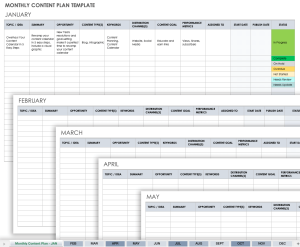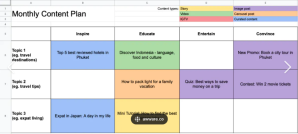Introduction

In the context of SEO, content planning and content strategy are two distinct concepts that are often used interchangeably. However, they have different meanings and purposes.
Content planning is the process of creating a roadmap for the content you want to create. It involves identifying the topics you want to cover, the types of content you want to create, and the channels you want to use to distribute your content. Content planning is focused on the tactical aspects of content creation.
On the other hand, content strategy is a more strategic approach to content creation. It involves defining the goals of your content, identifying your target audience, and creating a plan to achieve those goals. Content strategy is focused on the big picture of content creation.
In the context of SEO, content planning is an important part of content strategy. Before you can create content that ranks well in search engines, you need to have a plan for what you want to create and how you want to create it. Content planning helps you create content that is relevant to your target audience and optimized for search engines.
In summary, content planning is the process of creating a roadmap for your content, while content strategy is a more strategic approach to content creation that involves defining your goals and creating a plan to achieve them 123.
Content Planning
Content planning is a crucial step in any content marketing strategy. It involves defining what content you’re going to publish, when, and where. With an effective content plan, you can prioritize tasks, organize the creation process, and keep track of your progress. Creating a content plan is a key step in any content strategy. No matter the types of content you create (such as images, videos, or blog posts) or the platforms you use to distribute it (such as Instagram, YouTube, or your blog).
There are many resources available online that can help you create a content plan. For example, Semrush provides a comprehensive guide on how to create a content plan for any type of content and any platform, with a clear strategy, audience research, and a template 1. Hootsuite also offers an 8-step guide on how to create a winning content plan for your social media marketing strategy, covering the key elements of content planning, such as themes, campaign ideas, content mix, and scheduling, and provides tips and tools to help you plan effective, goal-crushing posts 2. Hubspot also provides a start-to-finish guide on how to create a content marketing plan that attracts and engages your target audience, meets your business goals, and drives results 3.
When it comes to content planning, there are several common mistakes that you should avoid. Here are some of them:
- Not having a clear strategy: Without a clear strategy, it’s difficult to create content that resonates with your audience and meets your business goals. A content strategy should define your target audience, the types of content you’ll create, the channels you’ll use to distribute it, and the metrics you’ll use to measure success 1.
- Not doing audience research: Audience research is essential to creating content that resonates with your target audience. You need to understand their needs, interests, and pain points to create content that addresses their concerns and provides value 2.
- Not having a content calendar: A content calendar helps you plan and organize your content creation process, ensuring that you publish content consistently and on time. It also helps you avoid last-minute content creation and ensures that your content is aligned with your business goals 3.
- Not diversifying your content: Creating the same type of content repeatedly can lead to audience fatigue. Diversifying your content by creating different types of content (such as videos, images, or blog posts) can help keep your audience engaged and interested 1.
- Not measuring your results: Measuring your content’s performance is essential to understanding what works and what doesn’t. You can use metrics such as page views, engagement rates, and conversion rates to measure your content’s effectiveness and optimize your content strategy accordingly 1.
Content Strategy

SEO content strategy is a plan that outlines how to create and publish content that will help your website rank higher in search engine results pages (SERPs) 1. A good SEO content strategy should include keyword research, content creation, and optimization, as well as a plan for promoting your content 2.
Here are some tips to help you create an effective SEO content strategy:
- Understand your target audience: Identify the people you want to reach with your content and what they are looking for. This will help you create content that is relevant and valuable to them 3.
- Conduct keyword research: Use tools like Ahrefs’ Keywords Explorer to find keywords with search traffic potential that your potential customers are searching for 2.
- Create high-quality content: Your content should be well-written, informative, and engaging. It should also be optimized for search engines by including relevant keywords and meta descriptions 4.
- Promote your content: Share your content on social media, email newsletters, and other channels to increase its visibility and attract more traffic to your website 1.
- Monitor and analyze your results: Use tools like Google Analytics to track your website’s traffic and see how your content is performing. This will help you identify areas for improvement and refine your SEO content strategy over time 1.
Remember, SEO content strategy is an ongoing process that requires continuous effort and optimization. By following these tips, you can create a solid foundation for your SEO content strategy and improve your website’s visibility in search engine results pages.
So in the content strategy, you have clear steps and actions to get to your defined goals that came in the plan.
On average, it takes 6-12 months for businesses to see results from SEO (search engine optimization) efforts 1. However, the timeline can depend on many factors such as your website history, competition, and the quality of your content 23.
SEO is an ongoing process that requires continuous effort and optimization. It’s important to monitor and analyze your results using tools like Google Analytics to track your website’s traffic and see how your content is performing. This will help you identify areas for improvement and refine your SEO content strategy over time 2.
Remember, SEO content strategy is an ongoing process that requires continuous effort and optimization. By following the tips I provided earlier, you can create a solid foundation for your SEO content strategy and improve your website’s visibility in search engine results pages.
Importance of Content Planning
Creating a content plan is a key step in any content project. No matter the types of content you create (such as images, videos, or blog posts) or the platforms you use to distribute it (such as Instagram, YouTube, or your blog). A content plan helps you to:
- Stay organized: A content plan helps you to stay organized by outlining what content you will create, when you will create it, and where it will be published. This helps you to prioritize tasks and ensure that you are creating content that aligns with your business goals.
- Save time: By planning your content in advance, you can save time by avoiding last-minute content creation. This also ensures that your content is aligned with your business goals and is of high quality.
- Improve quality: A content plan helps you to create high-quality content that resonates with your target audience. By doing audience research and understanding their needs, interests, and pain points, you can create content that addresses their concerns and provides value.
- Measure success: By measuring your content’s performance, you can understand what works and what doesn’t. This helps you to optimize your content strategy and create content that drives results.
Some Examples of Content Planning Models
Here are some examples of content plans that you can use as a reference:
- Content Marketing Strategy Plan: This plan outlines the key elements of a content marketing strategy, including the target audience, the types of content to create, the channels to use, and the metrics to measure success 1.
- Content Planning Calendar Template: This template helps you to map out and organize your content plan by content type or any category that suits your needs. You can add the content title, description, and theme, then assign ownership and key dates. You can track the status of each content piece, along with monthly performance metrics to determine which pieces are high performers and which need updates 2.
- Monthly Content Plan Template: This template helps you to plan and track content topics and ideas monthly. You can provide a summary of the topic, identify opportunities that exist with current search trends and seasonal patterns, then outline the content types, keywords, distribution channels, and more. You also have room to assign the topic, establish the start and publish date, and designate a status using the provided key 2.
- Content Inventory Audit Worksheet: This worksheet helps you to audit your existing content inventory and identify gaps in your content strategy. You can list all your content assets, including blog posts, videos, images, and more, then evaluate each asset based on its performance, relevance, and alignment with your business goals 2.
- Content Decision-Making Matrix Template: This template helps you to make data-driven decisions about your content strategy. You can evaluate each content idea based on its potential impact, feasibility, and alignment with your business goals, then prioritize the ideas based on their scores 2.


How to Create a Content Strategy For my Website?
Creating a content strategy for your website is an essential step in any content marketing plan. Here are the steps to create a content strategy for your website:
- Define your goals: Determine(by numbers, clear and possible) what you want to achieve with your content. Your goals could be to increase brand awareness, generate leads, or drive sales.
- Research your target audience: Conduct research to understand your target audience’s needs, interests, and pain points. This will help you create content that resonates with them.
- Conduct a content audit: Evaluate your existing content to identify gaps and opportunities. This will help you determine what content you need to create to achieve your goals.
- Choose your content types: Determine what types of content you want to create. This could include blog posts, videos, infographics, or podcasts.
- Create your content plan: Develop a plan for creating and publishing your content. This should include a content calendar, topics, and deadlines.
- Develop a process for content creation: Establish a process for creating and publishing your content. This should include roles and responsibilities, workflows, and quality control.
- Measure the success of your content: Use metrics such as page views, engagement rates, and conversion rates to measure the effectiveness of your content. This will help you optimize your content strategy and achieve your goals.
There are many resources available online that can help you create a content strategy for your website. For example, Hubspot provides a comprehensive guide on how to develop a content strategy in 7 steps, with a clear strategy, audience research, and a template 1. Google for Creators also offers a guide on how to create a content strategy that unifies and plans across different content channels 2.
Tools for Content Writing
There are many tools available online that can help you with content writing. Here are some of them:
- ContentShake: An all-in-one content writing tool that helps you get content ideas, write faster with AI, optimize copy with data-driven suggestions, and publish articles directly to WordPress 1.
- Grammarly: A grammar checker that checks your content for grammar, spelling, and punctuation mistakes. You can also use this tool to improve word choices, readability, and the tone of your content 1.
- Semrush’s SEO Writing Assistant: A content optimization tool that simplifies semantic SEO, helps improve readability and ensure originality, and provides actionable tips for improvement 1.
- Surfer: An SEO-friendly content writing tool that helps you optimize your content for search engines by analyzing your competitors’ content and providing data-driven recommendations 2.
- CoSchedule’s Headline Analyzer: A tool that offers data-driven insights related to the sentiment quotient, readability, and length of your headlines to help you edit and craft compelling headlines 1.
- Hemingway Editor: A tool that helps you improve the readability of your content by highlighting complex sentences, passive voice, and adverbs 1.
- ProWritingAid: An AI-powered content writing tool that helps you improve your writing by identifying grammar and spelling errors, improving sentence structure, and suggesting better word choices 2.
- Ulysses: A distraction-free writing space that helps you focus on your writing by providing a clean and minimalistic interface 1.
- 750 Words: A tool that helps you make writing a habit by encouraging you to write 750 words every day 1.
- Power Thesaurus: A tool that helps you improve your vocabulary by providing synonyms and antonyms for any word you enter 1.
- Evernote is a notes app that helps you remember everything from your everyday life. But, what is it doing in the list of content writing tools? You can use it for different purposes, such as taking notes, making to-do lists, and writing blog posts or articles. As one of the best content writing tools, Evernote helps you stay more organized and productive.
- If Google Docs isn’t already a standard app in your writing toolkit, it definitely ought to be. It’s included with any free Google account, and you can use it to write, edit, archive, and share your work with others.
- Word count tool
- Screenshot tool.
Tools for Content Strategy
There are many tools available online that can help you with content strategy. Here are some of them:
- Semrush: A comprehensive tool that provides a clear strategy, audience research, and a template for creating a content plan for any type of content and any platform 1.
- Hootsuite: Offers an 8-step guide on how to create a winning content plan for your social media marketing strategy, covering the key elements of content planning, such as themes, campaign ideas, content mix, and scheduling, and provides tips and tools to help you plan effective, goal-crushing posts 2.
- Hubspot: Provides a start-to-finish guide on how to create a content marketing plan that attracts and engages your target audience, meets your business goals, and drives results 3.
- CoSchedule: Offers a content calendar template that helps you map out and organize your content plan by content type or any category that suits your needs. You can add the content title, description, and theme, then assign ownership and key dates. You can track the status of each content piece, along with monthly performance metrics to determine which pieces are high performers and which need updates 1.
- Google Analytics: A free tool that helps you measure the effectiveness of your content by providing insights into your website traffic, user behavior, and conversion rates. You can use this tool to optimize your content strategy and improve your website’s performance 1.
- Trello: A project management tool that helps you organize your content creation process by creating boards, lists, and cards. You can assign tasks, set deadlines, and collaborate with your team to ensure that your content is published on time and meets your business goals 1.
- Asana: A project management tool that helps you manage your content creation process by creating tasks, assigning them to team members, and tracking their progress. You can also use this tool to collaborate with your team and ensure that your content is aligned with your business goals 1.
- Airtable: A project management tool that helps you organize your content creation process by creating tables, views, and records. You can use this tool to assign tasks, set deadlines, and collaborate with your team to ensure that your content is published on time and meets your business goals 1.
Conclusion
With all that said about planning and defining the content creation strategy, you have an introduction about how to start your content project with a good guide to lead the way. Review the examples of the plan and goals and tools to create the best plan for your coming project. For more about these points, see the next More Resources section and continue your journey.
More Resources
- Content Strategy vs. SEO Strategy: How to Decide Which Comes First | Databox Blog
- Content Planning vs Content Strategy: Are They Different?
- How to Create an SEO Content Strategy (Follow the Ahrefs’ Framework)
- How to Create a Content Plan, Step by Step
- Content Planning for Social Media: An 8-Step Guide for 2023
- How to Develop a Content Strategy in 7 Steps: A Start-to-Finish Guide
- The Importance Of Creating A Content Plan And How To Get Started | Koozai
- What is a Marketing Plan & How to Write One [+Examples]
- 10+ Free Content Plan Templates | Smartsheet
- 21 Must-Have Content Writing Tools for Every Writer | Shane Barker
- The best AI writing generators in 2023 | Zapier
- 12 Content Editing Tools to Produce High Quality Writing






Leave a comment